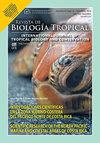热带干旱和红树林基质中脊椎动物生物多样性的模式
IF 0.6
4区 生物学
Q4 BIOLOGY
引用次数: 0
摘要
热带干燥森林和红树林是世界上最濒危的两个生态系统,它们各自拥有不同的环境条件,可能支持独特的物种组合。然而,很少有研究关注这两种栖息地并存的地区独特的脊椎动物生物多样性。目的:评价哥斯达黎加西北部未受保护地区红树林和热带干旱林基质中脊椎动物的多样性和生境利用模式。方法:在哥斯达黎加西北部圣罗莎国家公园南部Cabuyal湾和Zapotillal湾之间7平方公里的红树林和热带干燥森林中进行研究。2017年9月至2018年3月,我们利用13个自动相机陷阱,在1498个陷阱天内捕捉利用该区域的物种,并评估其空间和时间的栖息地利用模式。结果:共检测到27目42科70种脊椎动物,其中包括几种全球濒危物种。超过一半的物种仅在一个栖息地被发现,特别是鸟类(78%)和哺乳动物(42%)物种。热带干旱林比红树林和边缘生境拥有最多的独特物种和更大比例的草食动物,而红树林和边缘生境以肉食性和杂食性物种为主。在热带干燥森林中,从最冷最湿的月份(10月)到最热最干燥的月份(1月和2月),所有物种的相机陷阱平均检出率显著增加。基于样本的稀疏分析显示,调查长度足以对热带干林和边缘栖息地进行采样,但红树林需要进一步采样。结论:发现利用不同森林类型的分类群可能在其生命周期的不同阶段利用每种森林类型,随着全年环境条件的变化在不同区域之间移动。我们的研究证实了全球生物多样性倾向于食肉动物和杂食动物利用红树林的总体格局。本文章由计算机程序翻译,如有差异,请以英文原文为准。
Patterns of vertebrate biodiversity in a tropical dry and mangrove forest matrix
Introduction: Tropical dry forests and mangroves, two of the world’s most endangered ecosystems, each host a different set of environmental conditions which may support unique assemblages of species. However, few studies have looked at the unique vertebrate biodiversity in regions where both habitats occur side-by-side. Objective: To assess the vertebrate diversity and patterns of habitat usage in a mangrove and tropical dry forest matrix in an unprotected region of Northwestern Costa Rica. Methods: The study was conducted in a 7 km2 matrix of mangrove and tropical dry forests between Cabuyal and Zapotillal bays in Northwestern Costa Rica, South of Santa Rosa National Park. From September 2017 to March 2018, we used 13 automatic camera traps over 1 498 trap days to capture species utilizing the region and assess their patterns of habitat usage both spatially and temporally. Results: Seventy vertebrate species from 42 families in 27 orders were detected, including several globally threatened species. Over half of all species were detected in only one habitat, particularly amongst avian (78 %) and mammalian (42 %) species. Tropical dry forests hosted the greatest number of unique species and supported a greater percentage of herbivores than mangrove or edge habitats, which were dominated by carnivorous and omnivorous species. Mean detections per camera trap of all species increased significantly from the coldest and wettest month (Oct) to the hottest and driest months (Jan & Feb) in tropical dry forests. Sample-based rarefaction analysis revealed that survey length was sufficient to sample the tropical dry forest and edge habitats, though mangroves require further sampling. Conclusions: Taxa found to utilize different forest types may utilize each for different stages of their life cycle, moving between areas as environmental conditions change throughout the year. General patterns of global biodiversity favoring carnivore and omnivore usage of mangrove forests was confirmed in our study.
求助全文
通过发布文献求助,成功后即可免费获取论文全文。
去求助
来源期刊

Revista De Biologia Tropical
生物-生物学
CiteScore
1.80
自引率
0.00%
发文量
23
审稿时长
4-8 weeks
期刊介绍:
The Revista de Biología Tropical / International Journal of Tropical Biology and Conservation is a mainstream scientific journal published since 1953 and covered by Web of Science; Science Citation Index; Current Contents; Google Scholar; Scopus, SciELO and nearly 50 additional indices.
A double blind system guarantees you a fair evaluation, and our world class editorial and scientific boards provides a first decision in three working days. The journal is Full Open Access and is widely read where your article can have the highest real impact.
Since its beginning in 1953, the Revista follows these principles: objective and independent evaluation of all manuscripts; transparency in all processes; ethical use of procedures, data, specimens and subjects; fair treatment of all parties; and absolute predominance of scientific rigor over any other aspect.
 求助内容:
求助内容: 应助结果提醒方式:
应助结果提醒方式:


